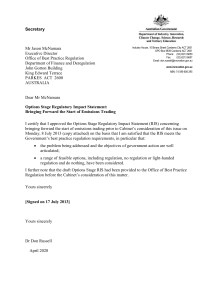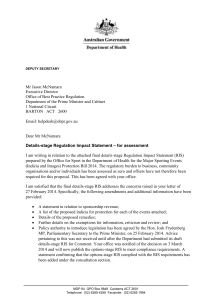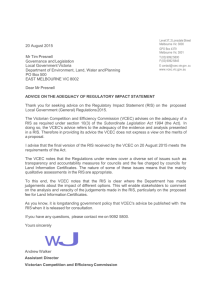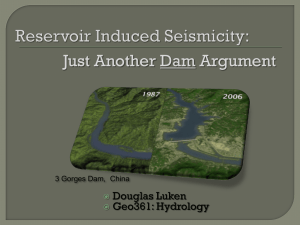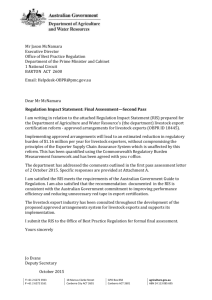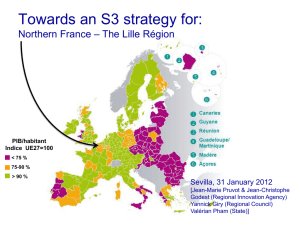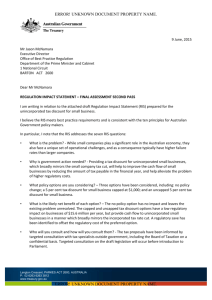update of the reservoir induced seismicity of brazil - 2008
advertisement
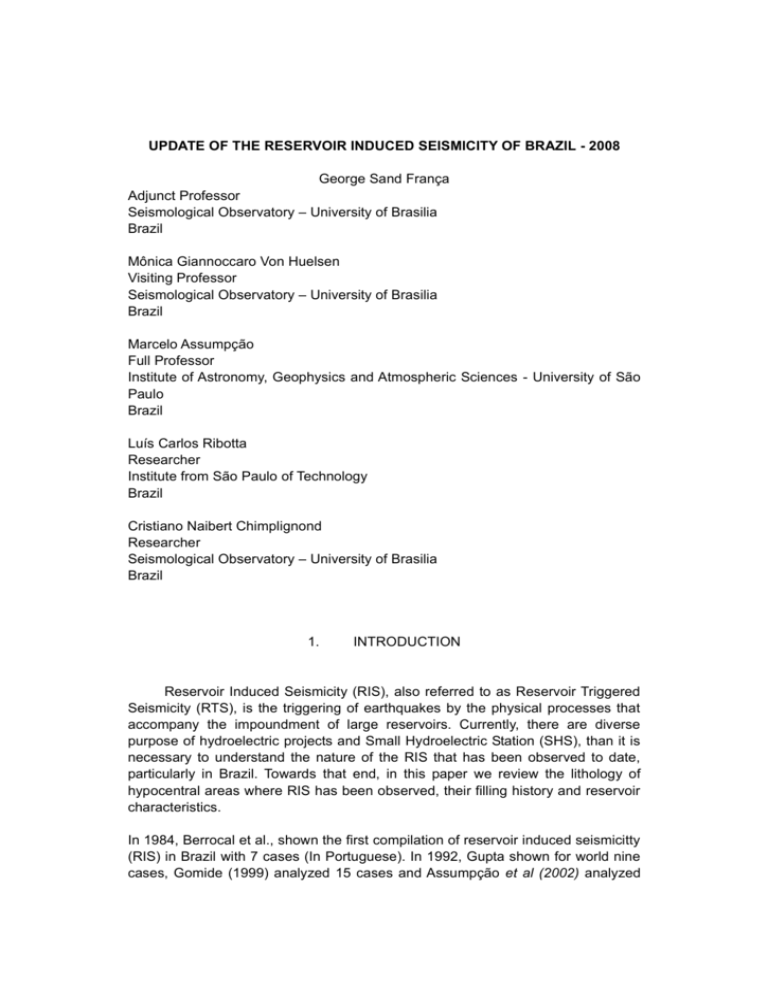
UPDATE OF THE RESERVOIR INDUCED SEISMICITY OF BRAZIL - 2008 George Sand França Adjunct Professor Seismological Observatory – University of Brasilia Brazil Mônica Giannoccaro Von Huelsen Visiting Professor Seismological Observatory – University of Brasilia Brazil Marcelo Assumpção Full Professor Institute of Astronomy, Geophysics and Atmospheric Sciences - University of São Paulo Brazil Luís Carlos Ribotta Researcher Institute from São Paulo of Technology Brazil Cristiano Naibert Chimplignond Researcher Seismological Observatory – University of Brasilia Brazil 1. INTRODUCTION Reservoir Induced Seismicity (RIS), also referred to as Reservoir Triggered Seismicity (RTS), is the triggering of earthquakes by the physical processes that accompany the impoundment of large reservoirs. Currently, there are diverse purpose of hydroelectric projects and Small Hydroelectric Station (SHS), than it is necessary to understand the nature of the RIS that has been observed to date, particularly in Brazil. Towards that end, in this paper we review the lithology of hypocentral areas where RIS has been observed, their filling history and reservoir characteristics. In 1984, Berrocal et al., shown the first compilation of reservoir induced seismicitty (RIS) in Brazil with 7 cases (In Portuguese). In 1992, Gupta shown for world nine cases, Gomide (1999) analyzed 15 cases and Assumpção et al (2002) analyzed 16 cases of RIS in Brazil with discussion for Precambrian Shield. They shown that the RIS didn't uniform and there are no correlation between RIS hazard and the lever natural seismicity. The last information about RIS from Brazil was in 2000, after that the several cases RIS occurred in Brazil without information. The following has the same idea, this present update summary of Brazilian cases may reinforce or the last the discussion about RIS hazard levels. 2. REVIEW Gupta (2002), in his review of studies on RIS, he highlights the following points: There are over 90 identified sites of earthquakes triggered by the filling of water reservoirs. The largest and most damaging earthquake triggered by a manmade reservoir was in 1967 in Koyna, India. The magnitude of the earthquake was 6.3. For him, the depth of the water in the reservoir is the most important factor in RIS. The volume of the water also pays a significant role in triggering an earthquake. The magnitude of the foreshock is higher than the magnitude of the aftershock and both values are generally higher than in cases of natural earthquakes. RIS can be immediately noticed during filling periods of reservoirs. The effect of RIS can be rapid (following the initial filling of the reservoir) or delayed (occurring later in the life of the reservoir). In accordance with Jauhari, 1999, the most widely accepted explanation of how dams cause earthquakes is related to the extra water pressure created in the micro-cracks and fissures in the ground under and near a reservoir. When the pressure of the water in the rocks increases, it acts to lubricate faults which are already under tectonic strain, but are prevented from slipping by the friction of the rock surfaces. 3. RIS IN BRAZIL Several cases of Brazilian reservoir where induced activity were describers in table 1 and table 2. Besides the 19 confirmed cases, eight other cases with doubtful seismicity have been included for the sake of completeness. The Fig. 1 illustrates the locations of RIS in Brazil. The height of the dam, maximum water, reservoir volume, dates of impoundments, predominant geology and Regional stress direction are given in Table 1. The longitude, latitude, maximum magnitude, reservoir, state, date of the largest event and type of seismicity are given in Table 2. The magnitudes adopted in this paper is the same Assumpção et al., 2002: mb for teleseismic events, mR (regional scale) for events recorded in the range 200 to 1500 km by Brazilian stations (Assumpção, 1983), M L (local magnitudes) and mD (Duration magnitude) for small events. The largest induced reservoir in Brazil was magnitude 4.2, associated with two reservoirs Porto Colômbia and Volta Grande, in November, 1973. In General, the reservoirs shows the an initial type and sometimes correlating with water level fluctuations, which could be classified perhaps as delayed behavior (for a detailed discussion, see Assumpção et al, 2002). Most of the reservoirs are in granitic region and the strike-slip faults predominant, but these characteristics are not so real because in general in Brazil has the same lithology. There are about 370 reservoirs in Brazil with a volume of 0.2 km 3 or greater, of these 19 (~ 5 %) are associated with RIS. Following the RIS near Irapé Reservoir (No. 18; Table 1) (Nascimento P. et al., 2008). 4. RECENT CASE OF RIS - IRAPÉ Irapé Reservoir has the highest Brazilian dam, width 208 meter high, and is located at Minas Gerais State, in the Jequitinhonha River. Since September 2003, nine months before the impoundment of the lake, the seismicity in the region started to be monitored. During this two years pre-impoundment monitoring no local event was detected at the area of the lake. The filling of the reservoir started in December 7, 2005, and was followed by microearthquakes just one day after. Until October 2006 more 300 events wore detected by this local network (Fig. 2). The largest microearthquake occurred in May 14, 2006 with 3.0m b magnitude. The clear time correlation between the start of impoundment of the lake and the occurrence of seismicity shows a causative relationship for this seismicity (Fig. 3). Also the spatial distribution of the epicenters let us to conclude that this is another case of reservoir-triggered seismicity in Brazil of the initial response type. 5. DISCUSSION AND CONCLUSIONS Brazil has 19 confirmed cases of RIS (Tables 1 and 2). The Fig. 1 is the update RIS (similar to Assumpção et al., 2002). Assumpção et al. 2002 and Marza et al. 1999, are list several characteristics, despite the small number of cases, p. e. RIS hazard in Brazil is not uniform, some areas to be prone to induced seismicity while the RIS hazard in other areas are much lower and there isn't correlation between RIS hazard, level natural seismicity ca be observed with present data and the deep reservoirs should not be used to reduce studies of RIS in small reservoirs (see Fig. 4). After update, we can see in table 2 that the initial type is predominant, another characteristics is the RIS, generally occur in boundary province, although the number of dams and hydroelectric power is larger than in the provinces. The scientific exploration of RIS is still not well understood and is therefore not possible to predict and this work shows that we need more effort to understand RIS in Brazil, until now we have only seismicity studies with companies collaboration, but we need more support for scientific aspects for example “the earthquake forecast studies” or “correlations with geophysics and geologic methods”, these studies can help and understand the RIS in Brazil. These studies are our goals to do in future studies. We just have a statement: Not only, the seismic frequency can increase in areas whose activity seismic occurrence was previously low, but also the frequency can decrease in areas with seismic activity occurrence previously high. Acknowledgments We thank all Brazilian hydroelectric power companies (CEMIG, CESP, CHESF, COPEL, ELETRONORTE, ELETROSUL, FURNAS, ITAIPU) for allowing us to publish results of many years of seismic monitoring of their reservoirs. GSF and MA thank CNPq for their research grants. We are grateful to Kate Moura and Marina Dalla Costa for their valuable comments which enhanced the paper. REFERENCES [1] [2] [3] [4] [5] ASSUMPÇÃO, M. (1983), A Regional Magnitude Scale for Brazil, Bull. Seismol. Soc. Am. 73, 237-246. ASSUMPÇÃO, M. (1992), The Regional Intraplate Stress Field in South America, J. Geophys. Res. 97, 11.889-11.903. ASSUMPÇÃO, M., BARBOSA, J. R., BERROCAL, J., BASSINI, A., VELOSO, J. A. V., MARZA, V., HUELSEN, M., AND RIBOTTA, L. C. (1997), Seismicity Patterns and Focal Mechanisms in SE Brazil, Rev. Bras. Geofísica 15, 119-132. ASSUMPÇÃO, M. (1998), Focal Mechanisms of Small Earthquakes in SE Brazilian Shield: A Test of Stress Models of the South American Plate, Geophys. J. Int. 133, 490-498. ASSUMPÇÃO M., V.I. MARZA, L.V. BARROS, C.N. CHIMPLIGANOND, J.E.P. SOARES, J.M. CARVALHO, D. CAIXETA, A. AMORIM AND E. [6] [7] [8] [9] [10] [11] [12] [13] [14] [15] [16] [17] [18] [19] CABRAL,(2002) Reservoir induced seismicity in Brazil, Pure Appl. Geophys. 159, pp. 597–617. BERROCAL, J., ASSUMPÇÃO, M., ANTEZANA, R., DIAS NETO, C. M., ORTEGA, R., FRANÇA, H., AND VELOSO, J. (1984), Sismicidade do Brasil. IAG-USP/CNEN, São Paulo, Brazil, 320 pp.(In Portuguese). CBGB (1999), Registro Nacional de Barragens, Brazilian Committee on Large Dams, CD-ROM. FERREIRA, J. M., OLIVEIRA, R. T., ASSUMPÇÃO, M., MOREIRA, J. A. M., PEARCE, R. G., AND TAKEYA, M. (1995), Correlation of Seismicity and Water Level in the Acu Reservoir - An Example from NE Brazil, Bull. Seismol. Soc. Am. 85(5), 1483-1489. FERREIRA, J., OLIVEIRA, R. T., TAKEYA, M. K., AND ASSUMPÇÃO, M. (1998), Superposition of Local and Regional Stresses in NE Brazil: Evidence Form Focal Mechanisms around the Potiguar Marginal Basin, Geophys. J. Int. 134, 341-355. FERREIRA J. M., G.S. FRANÇA, C.S. VILAR, A.F., DO NASCIMENTO, F.H.R. BEZERRA, M. ASSUMPÇÃO, (2008) Induced seismicity in the Castanhao reservoir, NE Brazil -- Preliminary results, Tectonophysics, V 456, I 1-2, The Monitoring of Induced Seismicity: Observations, Models and Interpretations, Pages 103-110, ISSN 0040-1951, DOI: 10.1016/j.tecto.2006.11.011. GISMAP - www.gismaps.com.br/ GOMIDE, L. C. (1999), Nature and History of Reservoir-induced Seismicity in Brazil, M.Sc. Thesis, Univ. of South Carolina, 60 pp GUPTA, H. K., 2002. “A review of recent studies of triggered earthquakes by artificial water reservoirs with special emphasis on earthquakes in Koyna, India.” Earth-Science Reviews 58 279–310. JAUHARI, V.P., 1999. Prepared for Thematic Review IV.5. “Options Assessment- Large Dams in India Operation, Monitoring and Decommissioning of Dams” www.dams.org LIMA, C., NASCIMENTO, E., AND ASSUMPÇÃO, M., (1997), Stress Orientations in Brazilian Sedimentary Basins from Breakout Analysis Implications for Force Models in the South American Plate, Geophys. J. Int. 130(1), 112-124. MARZA, V. I., BARROS, L. V., SOARES, J. E. P., CARVALHO, J. M., FONTENELLE, D. P., CHIMPLIGNOND, C, N., CAIXETA, D. F., GOMES, I. P., FURTADO, G. O., CARIM, A. L., SOUZA, I. F., CALIMAN, E. H., AND BARROS J. B. (1999), Some Aspects of Reservoir-induced Seismicity in Brazil, Proc. 23rd Brazilian Congr. on Large Dams, Belo Horizonte, Brazil, vol. 1, 199-211 (in Portuguese with English abstract). MENDIGUREN, J. A. (1980), A Procedure to Resolve Areas of Diferent Source Mechanisms When Using the Method of Composite Nodal Plane Solution, Bull. Seismol. Soc. Am. 70, 985-998. NASCIMENTO P. F. ; CHIMPLIGANOND C. N. ; FRANÇA, G. S.; ROIG H. L. (2008) Sismicidade Induzida por Reservatório de UHE Irapé. In: 44 Congresso Brasileiro de Geologia, 2008, Curitiba. RIBOTTA L. C., MIOTO J. A., MANUZZI J. L., CARVALHO A. M. B. & VINCIPROVA G. (2008) Sismicidade na área do reservatório de Barra Grande, SC/RS. In: III Simpósio Brasileiro de Geofísica, 2008, Belém. [20] VELOSO, J. A. V. (1992), Terremotos induzidos pelo homem, Ciencia Hoje 14, 66-72. [21] VILAR, C. S. ; FERREIRA, J. M. ; DO NASCIMENTO, A. F. ; BEZERRA, F. H. R. ; FRANÇA, G. S. . Atividade sísmica em Apodi-RN, natural ou induzida?. Ciência Sempre - Revista Fapern, v. 6, p. 58-63, 2007. Table 1 Reservoirs Characteristics References: (A) Assumpção (1992). (B) Assumpção et al. (1997). (C) Assumpção (1998b). (D) Ferreira et al. (1995). (E) Ferreira et al. (1998). (F) Lima et al.(1997). (G) Mendiguren (1980). (H) Ribotta et al. (2008) , (I) Nascimento et al. (2008) , (J) Ferreira et al. (2008) , (L) Ribotta (communication pessoal) (M) Vilar et al. (2007) , (N) Caixeta D. (Communication pessoal), (O) Veloso, (1992). N Dam name Dam height (state) (m) Maximum water depth(m) Reservoir Start of Predominant Volume (km3) Impoundment geology Regional Stress Shmax direction (reference) Porto Colombia 40 35 1.46 1973/Apr Basalt X Volta Grande (MG/SP) 45 37 2.30 1973/Sep Basalt X 2 Nova Ponte (MG) 142 132 12.8 1993/Oct Basalt Gneiss 3 Cajuru (MG) 23 20 0.20 1954 Granite Gneiss 4 Capivara (PR/SP) 60 55 10.5 1976/jan Basalt X 5 Tucuruí (PA) 106 90 45.8 1984/Sep Metamorphic X 6 Balbina (AM) 42 35 17.5 1987/Oct Sediments Compression?;NN granite-gneiss W-SSE? (A, F) 7 Miranda (MG) 85 82 1.14 1997/Aug Basalt Gneiss Paraibuna- 98 90 4.74 1974 Granite Gneiss Paratinga (SP) 104 90 4.74 1976 Granite Gneiss Jaguari 67 53 1.5 1969/Dec Granite Gneiss X 61 58 0.18 1970/Jul Gneiss X 1 Compression; NNESSW (B) Strike-slip; E-W (B,C) Compression; NNESSW? (B) Strike-slip; NE-SW (G) 8 9 10 Capivari-Cachoeira (PR) 11 Assu (RN) 31 31 2.4 1985 Granite Gneiss 12 Serra da Mesa (GO) 150 146 54.4 1996/Oct Granite 13 Marimbondo (MG/SP) 90 86? 6.15 1975 Basalt 14 Sobradinho (BA) 43? 40 34.1 1977 15 Emborcação (MG/GO) 158 154 17.5 1981/Aug Granite Gneiss/Schist Gneiss Strike-slip; NE-SW (G) Sthike-slip; E-W (D, E) Compression; NNW-SSE (A) X X X 16 17 Xingo (SE/AL) 140 110? 3.8 1994/Jun Metamorphic X Machadinho (SC/RS) 79 126 3.34 2001/Aug Basalt X (H) Barra Grande (SC/RS) 93.4 186 5.2 2005/Jun Basalt X (H) 34.6 188 1.48 2005/Oct Basalt X (H) Campos Novos (SC/RS) Quartzite 18 Irapé (MG) 208 137 ?? 205/Dec 19 Castanhão (CE) 60 ?? 4.5 2002 Gneiss Migmatites (J) MetaBasalt Strike-slip (I) Doubtful cases 01 Peti (MG) 43 42 0.042 1946 Gneiss X(O) 02 Furnas (MG) 127 106 23 1963 Quartizite Strike-slip; E-W (A) 03 Três Marias (MG) 70 60? 21 1962 Sediment X 04 Quebra-Queixo (SC) 5.6 75 0.136 2003/mar Andesito Dacito (L) 05 Três Irmãos (SP) 77 46 13.4 1999/Aug X (L) 57.5 ??? 0.6 2002 ??? (M) 30 4.982 ??? 06 Santa Cruz do Apodi (RN) 07 Lajeado (TO) 43 08 Itapebi (MG) 60 Granit Granodiorito Gnaisse Migmatito Ortognaisse Strike-Slip(N) Strike-slip Table 2 Characteristics of the induced seismicity: H_water is meter long. -48.47 -47.70 -44.75 -51.01 -49.63 -59.6 -47.96 -45.60 -46.06 -48.9 -36.9 -48.31 -48.9 -41.0 -47.9 -37.8 -42.58 -51.78 -51.22 -52.55 -42.61 -37.799 -38.5 -52.55 -51,22 lat. -20.04 -19.17 -20.28 -22.84 -3.86 -1.9 -18.96 -23.42 -23.17 -25.1 -5.8 -13.79 -20.3 -9.4 -18.45 -9.6 -16.72 -27.52 -27.77 -26.67 -16.76 -5.768 -5.5 -26.67 -20,67 mb 4.2 4.0 3.7 3.7 3.6 3.7 3.3 3.0 3.0 2.8 3.0 2.2 2.0 2.0 2.0 2.0 3.0 1.8 2.5 1.8 3.0 2.3 1.4 0.1 0.1 H_water 40 132 20 55 90 35 82 88 53 54 33 134 86 41 154 110 200 79 93.4 34.6 208 57.5 60 75 46 Reservoir Porto Colombia Nova Ponte Cajuru Capivara Tucurui Balbina Miranda Paraibuna Jaguari Capivari-Cachoeira Assu Serra da Mesa Marimbondo Sobradinho Emborcacao Xingo Irape Machadinho Barra Grande Campos Novos Irapé Santa Cruz do Apodi Castanhão Quebra-Queixo Três Irmãos State MG/SP MG MG SP/PR PA AM MG SP SP PR RN GO MG/SP BA MG/GO SE/AL MG SC/RS SC/RS SC/RS MG RN CE SC SP Date 1974.02.24 1998.05.22 1972.01.23 1979.03.27 1998.03.02 2001.05.27 2000.05.06 1977.11.16 1985.12.17 1971.05.21 1994.08.26 1998-06.13 1978.07.25 1979.07.05 1984.05.18 1994.07.20 2006.05.14 2008 2008 2008 2006.05.14 2005.05.27 2004 ??? ??? Type Initial Initial&Delayed Delayed Initial&Delayed Initial&Delayed Initial&Delayed Initial&Delayed Initial Delayed Initial Delayed Initial Initial Initial Initial Initial Initial Initial Initial Initial Initial Delayed Initial&Delayed ??? ??? Figure 1: Location of the reservoirs with induced seismicity. The lines refer to the main geological provinces in Brazil. Figure 2: Seismicity in Irapé (No. 18), State of Minas Gerais. Epicentral distribution: triangles denote seismographic stations; circles denote epicenters and square denote cities. Figure 3: Temporal evolution: number of monthly events (histogram), monthly averaged water level (thick line) in Irapé Reservoir. Figure 4: Natural and Induced Seismicity of Brazil (Assumpção et al. 2002 and Marza et al. 1999). Thin lines refer to main geological provinces in Brazil. AM – Amazon basin, BP – Borborema Province, CBS – Central Brazil Shield, GS – Guyana shield, PB – Parnaíba basin, PR – Paraná basin, SFC – São Francisco craton 6. SUMMARY AND KEYWORDS The first compilation of Brazilian seismicity was had in 1984, ever since, more than 40 cases were registered and compiled. This objective research is to understand the nature of the RIS that has been observed to date, particularly in Brazil. It was exposed here a synopsis of the historical cases of RIS in Brazil, a review the lithology of hypocentral areas where RIS has been observed, their filling history and reservoir characteristics. Joining to cases of Brazil RIS was presented recent case, in Irapé Reservoir. In a general way, we can observe that, at Brazil the effect of RIS is mainly of the fast type (following the initial filling of the reservoir). Another characteristic is: the RIS generally occur in boundary province, although the number of dams and hydroelectric power is larger than in the provinces. The scientific exploration of RIS is still not well understood and this work shows that we need more effort to understand RIS in Brazil. Finally it’s important observe that seismic frequency can change after the build of a dam. Keywords: Reservoir Induced Seismicity; RIS hazard; Brazilian seismicity; 7. RÉSUMÉ E MOTS CLEFS La prima compilazione di sismicità brasiliana era avuta in 1984, da allora, più di 40 casi erano iscritti ed erano compilati. Questa ricerca oggettiva è capire che la natura del RIS che è stato osservato per datare, particolarmente in Brasile. Era qui esposto un sommario dei casi storici di SIGNORE in Brasile, una revisione il lithology di aree di hypocentral dove RIS è stato osservato, le loro caratteristiche di storia e serbatoio riempendo. Unire ai casi di Brasile RIS era presentato il caso recente, nel Serbatoio di Irapé. In una maniera generale, possiamo osservare ciò, a Brasile l'effetto di RIS è principalmente del tipo veloce (seguendo il riempire iniziale del serbatoio). Un'altra caratteristica è: il RIS accade generalmente nella provincia di limite, sebbene il numero di dighe ed il potere idroelettrico è più grande di nelle province. L'esplorazione scientifica di RIS bene non è tuttavia capita e queste mostre di lavoro che abbiamo bisogno di più sforzo per capire RIS in Brasile. Finalmente è importante osserva quella frequenza sismica può cambiare dopo che il costruisce di una diga. Mots clefs : Il serbatoio Ha Indotto la Sismicità; il pericolo di RIS; la sismicità brasiliana
